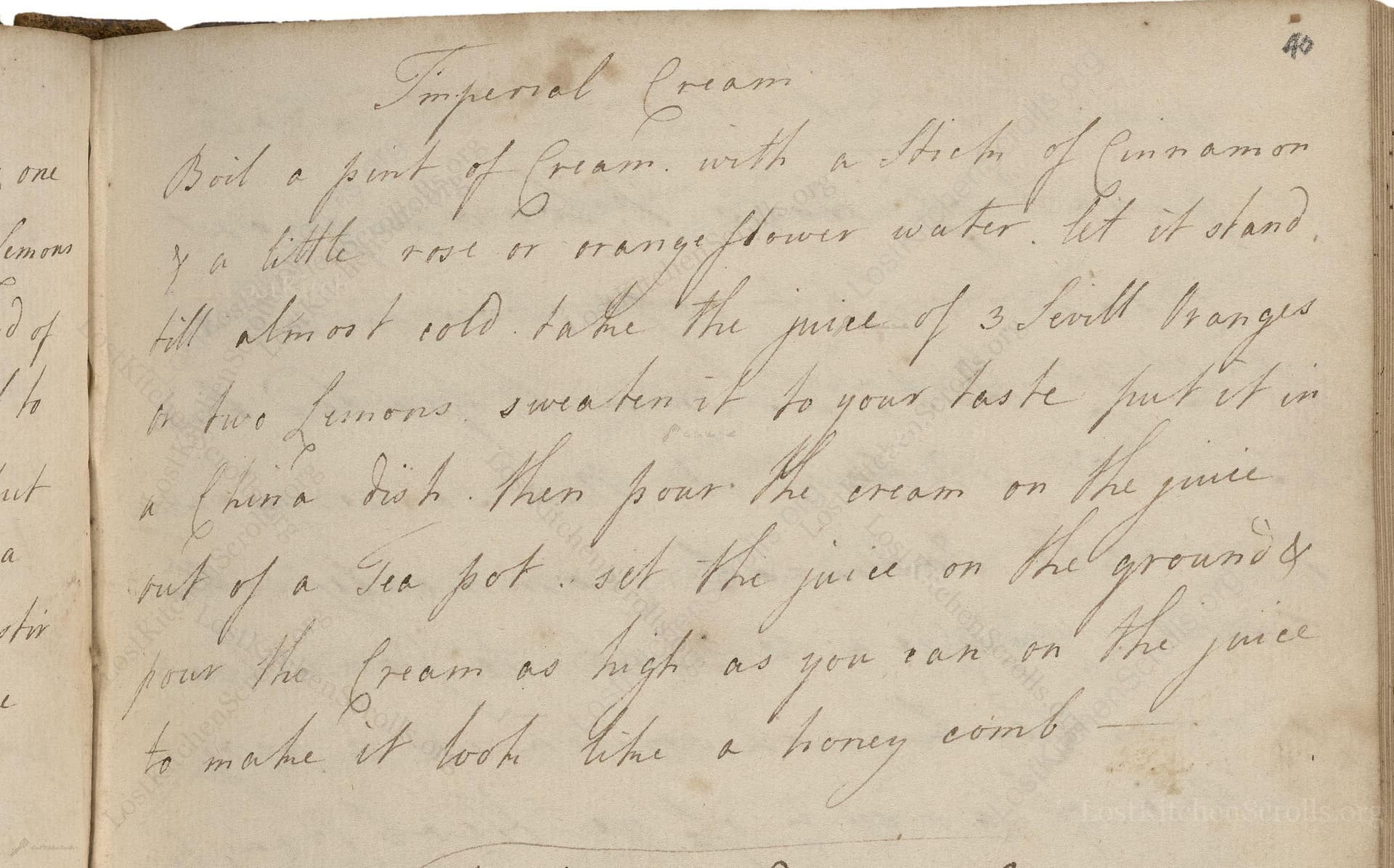Imperial Cream
From the treasured pages of Cookbook of Elizabeth Langley
Written by Elizabeth Langley

Imperial Cream
"Boil a pint of Cream. with a Stick of Cinnamon & a little rose or orange flower water. Let it stand till almost cold. take the Juice of 3.Sevill Oranges & two Lemons. Sweeten it to your taste put it in a China dish. Then pour the Cream on the Juice out of a Tea pot. orSet The juice on the ground & pour the Cream as high as you can on the juice to make it look like a honey comb—"
Note on the Original Text
This recipe, like many from the period, is delightfully concise and assumes familiarity with both the ingredients and kitchen techniques. Measurements are imprecise ('a pint', 'sweeten it to your taste'), reflecting a culinary culture reliant on intuition and experience rather than standardization. Spelling and capitalization follow 18th-century conventions—for example, 'Cream.' and 'Sevill Oranges'—and the instructions often run in a continuous sentence with little punctuation. The style is conversational and direct, aiming for effect and outcome rather than procedural detail.

Title
Cookbook of Elizabeth Langley (1757)
You can also click the book image above to peruse the original tome
Writer
Elizabeth Langley
Era
1757
Publisher
Unknown
Background
Step into the Georgian kitchen with Elizabeth Langley's 1757 culinary collection, where refined techniques and delightful recipes await those with a taste for historic gastronomy.
Kindly made available by
Folger Shakespeare Library
This recipe hails from mid-18th-century England, specifically from Elizabeth Langley, active around 1757. The dish reflects the growing fascination among the British elite with continental flavors and luxurious ingredients, like citrus and floral waters, which became increasingly accessible with expanding trade routes. Impressively, this was an era before refrigeration or modern desserts; the delight lay as much in the playful chemistry of curdling cream with citrus as in the exotic flavors. Imperial Cream would often be served as a centerpiece for special occasions, offering both taste and a spectacular visual presentation.

The original cook would have used an open hearth with a pan or small pot for heating the cream. A wooden spoon or spatula was likely employed for stirring, and a porcelain 'china dish' acted as the serving vessel. A teapot, or any vessel with a spout, was prized for the final theatrical pouring of the cream. Strainers for the juice and mortar and pestle for sugar (if not already ground) were also common in such kitchens.
Prep Time
10 mins
Cook Time
10 mins
Servings
4
We've done our best to adapt this historical recipe for modern kitchens, but some details may still need refinement. We warmly welcome feedback from fellow cooks and culinary historians — your insights support the entire community!
Ingredients
- 2 cups heavy cream
- 1 stick cinnamon
- 1 tsp (or 1 teaspoon) rosewater or orange flower water
- Juice of 3 Seville oranges (substitute: regular oranges with a dash of lemon/lime if Seville not available)
- Juice of 2 lemons
- 3–4 tablespoons (1.5–2 oz) caster sugar, or to taste
Instructions
- Begin by bringing 2 cups of heavy cream to a gentle boil in a saucepan.
- Add a stick of cinnamon and a teaspoon (about 1 tsp) of either rosewater or orange flower water.
- Once the cream has been infused, remove it from the heat and let it cool until just warm, almost at room temperature.
- Meanwhile, juice 3 Seville oranges and 2 lemons, straining to remove seeds and pulp.
- Sweeten the juice to taste—start with about 3–4 tablespoons (1.5–2 oz) of caster sugar, stirring until dissolved.
- Pour the sweetened citrus juice into a shallow serving dish (e.g., a porcelain or glass dish).
- Then, with a flourish, pour the cooled cream from a height—using a teapot or jug—into the dish over the juice, so that the cream breaks into pockets, resembling a honeycomb.
- Do not stir.
- Allow the cream to set as the acid will slightly curdle and thicken it, creating a soft-set, tangy-sweet custard.
- Serve chilled.
Estimated Calories
320 per serving
Cooking Estimates
You will spend about 10 minutes prepping ingredients like juicing and measuring, and about 10 minutes cooking the cream. Each serving has an estimated 320 calories. This recipe makes 4 servings.
As noted above, we have made our best effort to translate and adapt this historical recipe for modern kitchens, taking into account ingredients nowadays, cooking techniques, measurements, and so on. However, historical recipes often contain assumptions that require interpretation.
We'd love for anyone to help improve these adaptations. Community contributions are highly welcome. If you have suggestions, corrections, or cooking tips based on your experience with this recipe, please share them below.
Join the Discussion
Rate This Recipe
Dietary Preference
Culinary Technique

Den Bockfisch In Einer Fleisch Suppen Zu Kochen
This recipe hails from a German manuscript cookbook compiled in 1696, a time whe...

Die Grieß Nudlen Zumachen
This recipe comes from a rather mysterious manuscript cookbook, penned anonymous...

Ein Boudain
This recipe comes from an anonymous German-language manuscript cookbook from 169...

Ein Gesaltzen Citroni
This recipe, dating from 1696, comes from an extensive anonymous German cookbook...
Browse our complete collection of time-honored recipes



